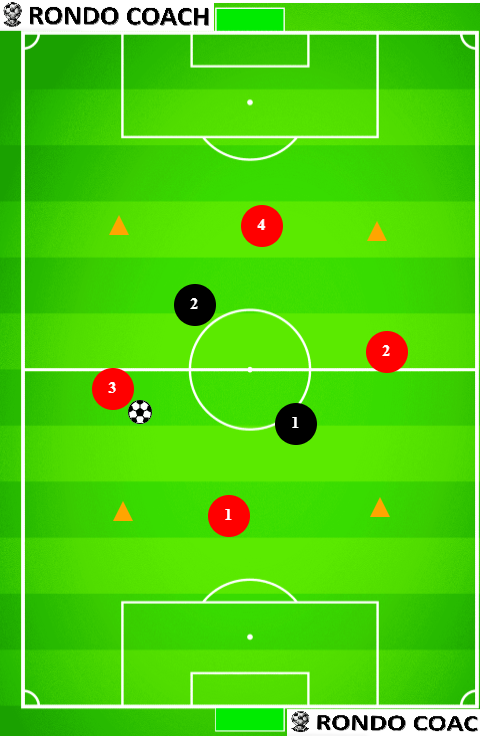4v2 Rondo [Complete Guide with Variations]
Now that we have mastered the 4v1 rondo and the 5v2 rondo, it’s time to move to the next step. The 4v2 rondo is the holy grail of rondos. It’s great for warming up and for skills, and it gives the right amount of decision-making opportunities. The expectation is to spend about a month on variations of the 5v2 before moving to the 4v2 rondo. One interesting rule to stimulate this transition is to count skipping the middle attacker as two points. The right pass is played, but the middle attacker needs to just skip the ball. This is very fun for the players and they have fun with it. Introduce this after 5v2 can keep the ball for 10 passes or more.
Why do the 4v2 rondo?
The 4v2 rondo is the core of soccer rondos. The reason for that is that when playing possession, the player with the ball mostly has 3 players around them to pass to. Now, with two defending players blocking passes, in theory, there should always be one option available. This also means that lost possession requires a mistake by the attackers, either technical or in their decision. We can vary the size of the allowed area or add additional rules, such as one-touch or two-touch only. However, this rondo is practiced from the early beginners all the way to the best teams in the world.
Setup
The setup is very simple – two defenders in the middle and 4 attackers on each side of the square. The rules have not changed for anybody and the game variations are similar to the 4v1. Initially, the player in the middle will block the far pass, so the first pass will always be to the side. At this point, the players will know the rules and will require with very few instructions. Also, they will know what you are asking from them, such as receiving with their back feet and opening up without the ball.
Variations of 4v2 rondo
There are many variations that we can do for the 4v2 rondo. We can definitely do similar things to what we’ve done, such as the winger target rondo or the throw-in rondo. We will set the players in situations to be under the right amount of pressure and situations in which they will have to adapt to the challenges. We will have more rondo lessons, such as the double rondo or the transitional rondo. Many of them are based on the 4v2 rondo, which is why it needs to be natural for the players before moving to more complex systems.
Wingers
Make the field narrow, say 2:3 ratio, where wingers play on the longer sides. They already did this for 4v1 and even 5v2, but when having only one option to pass, it will be much harder for the players. To make it more interesting, encourage extra points for transitioning the ball from two shorter sides. That way the defenders will definitely stay compact in the middle. Remember that not only the attackers learn in rondos, but also the defenders.
Throw in
You have already done the throw-in with the rondos at 5v2. Now, we remove one option for the first receiver. That might also mean that they would have to do one touch sometimes and two touches other times, depending on the situation. Earlier there were almost always options for one touch. This time we have a more realistic real-game representation. Also, with 2 defenders, it is more likely that the thrower will be called for a foul throw. You, as a coach, can still call it, but the players will do that themselves over time.
4v2 Transition Rondo
If your players have reached a point when they can perform well in a 4v2 rondo, it’s time to move to a more complex rondo. The traditional 4v2 rondo can have many stops and breaks. What you want instead is a continuous flow between attacking and defending. The transition 4v2 rondo achieves that with two players constantly overloading to achieve numerical superiority. In a simple setup, the players keep possession with 4 players, against 2. As soon as they lose possession, two of them drop out, and the new team in possession gains two players for overloading. This constant flow can be physically challenging, so it’s a good drill for stamina. More importantly, it’s exactly now a game would look like, with possession changing regularly. I recommend it from a very young age, as early as U10, all the way to the professional level.
RONDOS
No Opponents Rondo
Introduction to rondos with 3v0 and 4v0. Coaching passing, receiving, and the concept of “backfoot”.
First opponent
Introduce an opponent in the rondo. Create the need to move off the ball and think of passing lanes.
Increase intensity
Limit one passing option, and improve decision-making. Put pass-and-go into practice. Introduce a transition rondo to 5v3.
Increase complexity
Introduce team pressing of two players. Coach the central midfielder for the first time.
Pro Rondo
The rondo that pros play. Teaching to split the opponents with the right weight of the pass.
Positional play
All variations of the complex rondos before transitioning into positional play and game scenarios.

